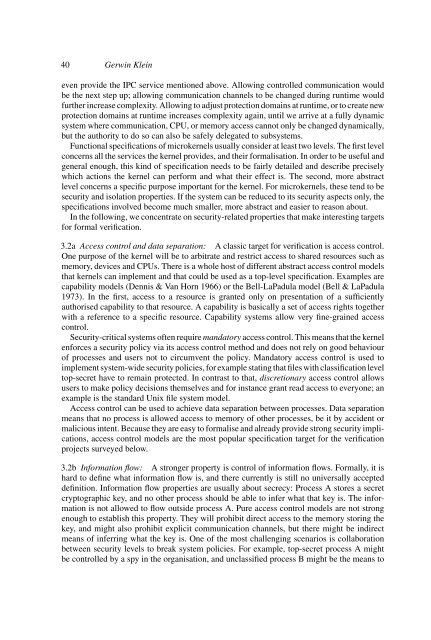Operating system verificationâAn overview
Operating system verificationâAn overview
Operating system verificationâAn overview
Create successful ePaper yourself
Turn your PDF publications into a flip-book with our unique Google optimized e-Paper software.
40 Gerwin Klein<br />
even provide the IPC service mentioned above. Allowing controlled communication would<br />
be the next step up; allowing communication channels to be changed during runtime would<br />
further increase complexity. Allowing to adjust protection domains at runtime, or to create new<br />
protection domains at runtime increases complexity again, until we arrive at a fully dynamic<br />
<strong>system</strong> where communication, CPU, or memory access cannot only be changed dynamically,<br />
but the authority to do so can also be safely delegated to sub<strong>system</strong>s.<br />
Functional specifications of microkernels usually consider at least two levels. The first level<br />
concerns all the services the kernel provides, and their formalisation. In order to be useful and<br />
general enough, this kind of specification needs to be fairly detailed and describe precisely<br />
which actions the kernel can perform and what their effect is. The second, more abstract<br />
level concerns a specific purpose important for the kernel. For microkernels, these tend to be<br />
security and isolation properties. If the <strong>system</strong> can be reduced to its security aspects only, the<br />
specifications involved become much smaller, more abstract and easier to reason about.<br />
In the following, we concentrate on security-related properties that make interesting targets<br />
for formal verification.<br />
3.2a Access control and data separation: A classic target for verification is access control.<br />
One purpose of the kernel will be to arbitrate and restrict access to shared resources such as<br />
memory, devices and CPUs. There is a whole host of different abstract access control models<br />
that kernels can implement and that could be used as a top-level specification. Examples are<br />
capability models (Dennis & Van Horn 1966) or the Bell-LaPadula model (Bell & LaPadula<br />
1973). In the first, access to a resource is granted only on presentation of a sufficiently<br />
authorised capability to that resource. A capability is basically a set of access rights together<br />
with a reference to a specific resource. Capability <strong>system</strong>s allow very fine-grained access<br />
control.<br />
Security-critical <strong>system</strong>s often require mandatory access control. This means that the kernel<br />
enforces a security policy via its access control method and does not rely on good behaviour<br />
of processes and users not to circumvent the policy. Mandatory access control is used to<br />
implement <strong>system</strong>-wide security policies, for example stating that files with classification level<br />
top-secret have to remain protected. In contrast to that, discretionary access control allows<br />
users to make policy decisions themselves and for instance grant read access to everyone; an<br />
example is the standard Unix file <strong>system</strong> model.<br />
Access control can be used to achieve data separation between processes. Data separation<br />
means that no process is allowed access to memory of other processes, be it by accident or<br />
malicious intent. Because they are easy to formalise and already provide strong security implications,<br />
access control models are the most popular specification target for the verification<br />
projects surveyed below.<br />
3.2b Information flow: A stronger property is control of information flows. Formally, it is<br />
hard to define what information flow is, and there currently is still no universally accepted<br />
definition. Information flow properties are usually about secrecy: Process A stores a secret<br />
cryptographic key, and no other process should be able to infer what that key is. The information<br />
is not allowed to flow outside process A. Pure access control models are not strong<br />
enough to establish this property. They will prohibit direct access to the memory storing the<br />
key, and might also prohibit explicit communication channels, but there might be indirect<br />
means of inferring what the key is. One of the most challenging scenarios is collaboration<br />
between security levels to break <strong>system</strong> policies. For example, top-secret process A might<br />
be controlled by a spy in the organisation, and unclassified process B might be the means to
















